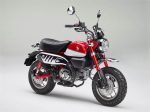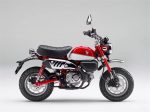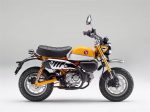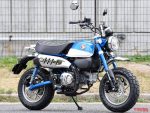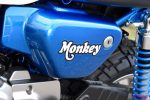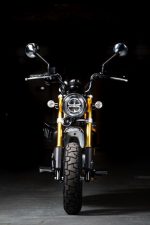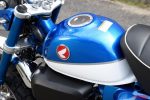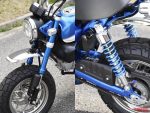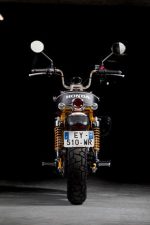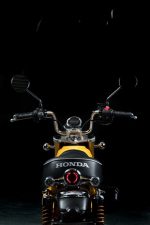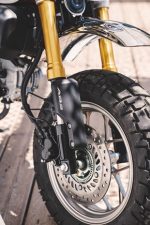– 2021 Honda Monkey 125 Review | Specs, Price, Changes, Colors, HP & TQ Performance, MPG + More! | 125cc Mini Bike / Motorcycle (miniMOTO) –
The 2021 Honda Monkey 125 is here! Now, it’s time to break down all of the nitty-gritty details about the 2021 Monkey 125 in a Review / Buyer’s Guide with every thing you need to know about this 125cc vintage / retro styled mini bike. First things first…
2021 Honda Monkey 125 VS 2020 Monkey 125 Changes? None. Honda didn’t make any mechanical changes to the Monkey for 2021 and all of the colors from 2020 carry over to 2021 as well. The first production year, 2019 you had Banana Yellow and Pearl Nebula Red to choose from. Then in 2020 you had the introduction of Pearl Glittering Blue which replaced Banana Yellow next to the Pearl Nebula Red. Now for 2021, it’s copy & paste from 2020.
You can follow the history of the Monkey 125’s story from concept to production and me discussing whether or not it would eventually release in the USA etc by Clicking Here. Getting a bike past that concept phase isn’t easy and can sometimes be a long road or even a road with a big fat dead-end sign to greet you at its end. Customer feedback whether it be at a motorcycle show that Honda attends or online via different social media outlets like Facebook, Twitter, Instagram, YouTube etc can have a huge affect so make sure to voice your opinions when you see something you like. You never know, that next concept bike you fall in love could end up making its way to production.
– Monkey 125 Walk-Around Video / Start-Up –
- Quick Overview of Key 2021 Monkey 125 Specs:
- 2021 Monkey 125 Price / MSRP – $3,999
- 2021 Monkey 125 ABS Price / MSRP – $4,199
- 2021 Monkey 125 Release Date – August 2020
- 2021 Monkey 125 Colors – Pearl Glittering Blue, Pearl Nebula Red
- 2021 Monkey 125 ABS Colors – Pearl Nebula Red
- 2021 Monkey 125 Miles Per Gallon – 157 MPG (est)
- 2021 Monkey 125 Horsepower – 9.3 HP @ 7,000 RPM
- 2021 Monkey 125 Torque – 8.1 ft/lb torque @ 5,250 RPM
- 2021 Monkey 125 Fuel Tank Capacity – 1.5 gal.
- 2021 Monkey 125 Weight – 234 lbs
- 2021 Monkey 125 ABS Weight – 238 lbs
- 2021 Monkey 125 Seat Height – 30.6 in.
- 2021 Monkey 125 Changes – None
- 2021 Monkey 125 Price / MSRP – $3,999
– New 2021 Honda Motorcycles Released! | Click Here –
– Custom Honda Monkey 125 | Click Here –
– Honda Monkey 125 Aftermarket Exhausts | Click Here –
- 2021 Monkey 125 Review Contents:
- 1. | Introduction / History
- 2. | Model Overview
- 3. | Monkey History / Milestones
- 4. | Pictures / Photo Gallery
- 5. | Technical Specifications
1. | 2021 Monkey 125 Introduction / History
Honda’s genuinely iconic mini-bike has now been re-imagined for the present day, with styling that draws heavily on the original, complemented by modern, premium touches such as USD forks, twin rear shocks, LCD instruments, IMU-based ABS and full LED lighting. ABS is standard equipment in other parts of the world but for the USA, it’ll be a $200 option for ABS just like the Grom 125. Its 125cc air-cooled engine delivers a earth shattering 9 horsepower, and fuel efficiency comes in at a staggering 157 MPG; curb weight with a full tank of fuel etc comes in at only 235 lbs.
The Honda Monkey bike is perhaps most widely known as a groovy icon of the 1970s, but it first saw the light of day in 1961. Originally developed as a 49cc child’s plaything for Tama Tech, an amusement park in Tokyo. There, Honda’s 49cc-powered Z100 was featured as part of an attraction designed to help park goers experience the joys of riding. So popular amongst guests of all ages and sizes that the bikes quickly earned the nickname of “Monkey,” a term originating from how the larger riders looked while riding around. So popular was the attraction that, in 1964, Honda began producing a street-legal version called the CZ100, for European and Asian countries. The craze had started, and it wasn’t long until America would get its first taste of how much fun a mini bike can be.
Waiting is the hardest part, but America’s delay for a true Honda mini bike ended in 1968, when the first Z50A was made available in the U.S., complete with 8-inch wheels, knobby tires, adjustable seat, and loveable styling. The best part? A folding handlebar meant parents could stow the bike in the trunk of a car and drive their children to the local riding spot—and probably even go for a ride themselves. Memories were being made, one ride at a time.
Its popularity was based on a cute, instantly-likable design, tiny dimensions and ultra light weight – which made it a whole load of fun around town. By 1969 its wheels had increased to 8-inch in diameter and from 1970 it gained even greater popularity, when the addition of quick-detach forks meant it would fit into the trunk of a small car.
Outfitted with a headlight and taillight, the 1969-1970 Z50A served as Honda’s quick adjustment to the widespread popularity of the model and opened the door to a wider range of riding. The trend continued, each Z50A being tweaked to fit the needs of its growing fanbase, and in the process, capturing the hearts of Americans. Fun, accessible mobility, through a likable design, tiny dimensions, and low weight, had caught on.
The Z50A’s design continued to evolve with features such as dual rear shocks, introduced in 1972.
From there, Honda’s North America-bound Z50A models evolved into machines bred for off-road riding, while Europe’s Z50J carried the torch as a fun machine for getting around town. But already, the Z50 and its Monkey namesake, had been cemented in millions of hearts by giving countless riders their first experience of twisting the throttle on a powered two-wheeler.
By 1978 – a point that marked the start of real prime time for the Monkey – the machine had been re-styled with a teardrop style fuel tank, and became hugely popular with legions of RV (Recreational Vehicle) drivers in need of convenient transport to use once they were parked up. And this is where and when the cheeky Monkey really cemented its place in millions of hearts; with its 3-speed gearbox and centrifugal clutch (which needed no ‘traditional’ motorcycle skill to operate) it gave thousands of riders their first experience of twisting the throttle on a powered two wheeler.
Because it was so much fun, and so easy to ride, it did more to sell the concept of motorcycles to a wider public than perhaps any other machine. With its chunky tires, mini-‘ape’ style handlebars, minuscule fuel tank and big, squashy seat the Monkey look is unmistakably of its time, but – just like the affection in which it is held – also timeless.
Today, the desire for an easy-to-handle motorcycle that puts a smile on not only the person riding it, but even those who aren’t, is alive and well, as evidenced by the success of Honda’s Grom. A master of fun, the 2019 Honda Monkey builds on that passion just like the Grom has the last few years, while celebrating the Z50A models that paved the way for so many riders through the 1960s and ’70s, and opening the door to the next generation of enthusiasts.
2. | 2021 Monkey 125 Model Overview
- Styling, paint and chromed parts draw heavily on the original
- 125cc air-cooled engine delivers 9 HP, 8.1 ft/lb torque and delivers 157 MPG (est)
- Steel frame, USD forks, twin rear shocks and 12-inch diameter tires
- Wet weight of 234 lbs, with wheelbase of 45.3 in. and 30.6 in. seat height
- All lighting is premium LED
After the modern-day success of the sharp-suited Grom / MSX125, which proved the desire for a funky, pocket-sized town run-around, it was time for the Monkey name to return, reborn and ready for life in the 21st century city.
Naturally the classic Monkey style had to provide the cues for the new model. A trapezoid silhouette highlights the compact length, while adding depth and substance to its stance. Simple, curved surfaces are designed independently of each other and feature throughout.
The glossy 1.5 gal. fuel tank, finished in the same paint color as the frame, swing arm and rear shocks, crowns the machine, and proudly wears a historical 3-D Old Wing design Honda logo. Chromed steel high-level front and rear mudguards – plus the evocatively-stamped exhaust shield, circular mirrors and high-rise handlebars – all pay homage to the original.
Modern technology is fully present within the evocative reincarnation of the classic look: a digital full-LCD circular meter features speedometer (which winks playfully when the ignition is turned on), odometer with two trip meters and six-segment fuel level indicator; all lighting is LED; the ‘wave’ pattern key (which also wears the Old Wing motif) features an ‘answer back’ system that makes the lights flash at the push of a button to allow easy location in crowded car parks; the single channel ABS system operates with an IMU to mitigate rear ‘lift’ under strong braking.
As for the Monkey’s engine, true to its origins, the Monkey’s horizontal SOHC 125cc single-cylinder engine is simple, robust and tuned to deliver useful about-town performance. Air-cooled, with bore and stroke of 52.4 x 57.9mm and compression ratio of 9.3:1, fed by PGM-FI, it produces 9 horsepower @ 7,000rpm and 8.1 lb/ft of torque @ 5,250rpm. The gearbox is 4-speed and the engine returns fuel economy exceeding 130 MPG.
Compared to the Honda Grom, the Monkey shares more of the same engine details than what are actually different. They are identical in bore and stroke as well as compression ratio. The Grom makes less than one more horsepower and there is only about .1 of a difference when it comes to their torque numbers but max torque comes in about 250 RPM sooner whereas their peak horsepower figures both come in at 7,000 RPM. I haven’t been given the gear ratio numbers yet but I would almost bet money that they are identical as well as sprocket counts up front and in the rear. The Monkey does come in at about 10 more pounds but that is only if you’re comparing it to a non ABS model Grom, if you compare apples to apples and ABS versus ABS model then it’s less than a full pound of difference. Long story short, if you’re wanting to know how the Monkey 125 VS Grom 125 race would turn out… I would say that the guy winning that race would be whoever had the lighter breakfast that morning and has more skills than the next guy. The nitty-gritty performance details and specs when comparing the Monkey versus Grom are just too similar for there to be a clear winner.
The Monkey’s steel backbone frame has been tuned for a suitable balance between rigidity and supple feel – perfect for the wide variety of conditions the machine is sure to be ridden in. Oval in cross-section, the swingarm echoes the circular design theme that runs through the bike.
Wheelbase is set at 45.5 in., while rake and trail are set at 25°/82mm for confidence-inspiring handling and a minimum turning radius of just 6.2 ft. Wet weight is a mere 235 pounds with a tank full of gas and all fluids, with a seat height of 30.5 inches. The plush seat is made of high-density urethane for maximum comfort.
The inverted USD front forks wear a premium Alumite finish and are matched by dual rear shocks with 4 inches of suspension travel. Maximum ground clearance is 6.3 inches. A single 220mm front disc and 190mm rear provide secure stopping performance, and on the ABS Monkey, braking up front is managed by the IMU-based ABS. Fat 12-inch block pattern tires make for a smooth ride and are sized 120/80-12 65J front and 130/80-12 69J rear.
Honda Monkey Milestones
1961 Honda Monkey
First model—made for use at amusement parks, with 5-inch wheels, rigid suspension, foldable handlebars, and 4.2 hp 49cc engine.
1963 Honda Monkey
First road-going model – exported to North America and Europe.
1967 Honda Monkey
First model sold in Japan – with ‘fold-down’ seat.
1970 Honda Monkey
Quick-detach front suspension made it possible to fit in the trunk of a small car.
1978 Honda Monkey
First model with custom bike style ‘tear drop’ fuel tank.
1984 Honda Monkey
Limited edition ‘Gold’ model.
1987 Honda Monkey
‘R’ model with twin tube frame and hydraulic front brake disc. This made its way to the USA, known as the ZB50 and has been on my list of bikes I absolutely “need” but coming across one is like finding a needle in a haystack since it was only sold in the USA for one production year, 1988. Insert sad face here.
1991 Honda Monkey
Off-road styled ‘Baja’ model with twin headlights.
2004 Honda Monkey Special
In colors based on the CB750F ridden to victory in the Daytona 100 by the master himself, Freddie Spencer.
2009 Honda Monkey Limited
The first fuel-injected version of the Monkey and also outfitted with a roller rocker arm setup in the head and an off-set cylinder.
2017 Honda Monkey 50th Anniversary Edition
This version commemorates the 50th Anniversary of sales for the Monkey in Japan.
4. | 2021 Monkey 125 Pictures / Photo Gallery
5. | 2021 Monkey Technical Specifications
| Model | MONKEY ABS | MONKEY |
| ENGINE | ||
| Type | 124.9cc air-cooled single-cylinder four-stroke | |
| Valve Train | SOHC; two-valve | |
| Bore x Stroke | 52.4mm x 57.9mm | |
| Compression Ratio | 9.3:1 | |
| Induction | PGM-FI w/ 24mm bore, automatic enrichment | |
| Ignition | Full transistorized | |
| Starter | Electric | |
| Transmission | Manual; four speeds | |
| Clutch | Multiplate wet | |
| Final Drive | Chain final drive; 15T/34T | |
| SUSPENSION | ||
| Front | 31mm hydraulic telescopic inverted fork; 4.3 in. travel | |
| Rear | Twin shocks; 3.3 in. travel | |
| BRAKES | ||
|
Front |
Hydraulic; single 220mm disc w/ two- piston caliper; ABS |
Hydraulic; single 220mm disc w/ two-piston caliper |
| Rear | Hydraulic; single 190mm disc w/ single-piston caliper | |
| TIRES | ||
| Front | 120/80-12 | |
| Rear | 130/80-12 | |
| MEASUREMENTS | ||
| Rake (Caster Angle) | 25º | |
| Trail | 82mm (3.2 in.) | |
| Length | 67.4 in. | |
| Width | 29.7 in. | |
| Height | 40.5 in. | |
| Ground Clearance | 5.3 in. | |
| Seat Height | 30.6 in. | |
| Wheelbase | 45.3 in. | |
| Fuel Capacity | 1.5 gal. | |
| Colors | Pearl Nebula Red | Pearl Glittering Blue |
| Curb Weight* | 236 lbs. | 232 lbs. |
* Includes all standard equipment, required fluids and full tank of fuel—ready to ride Meets current EPA standards.



































